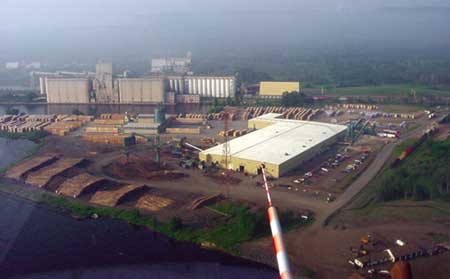NORTH AMERICAN REPORTS
Get the Land Back First
Water and land rights are at the heart of several progress points for Native American economic development. In Idaho this year, the Nez Perce tribe dropped its claim to nearly all the water in the Snake River Basin in exchange for 50,000 acre-feet

|
| This Bowater sawmill sits on part of an 1,100-acre (445-hectare) swath of land handed back to Fort William First Nation near Thunder Bay, Ont., by CN after 100 years of possession. Plans call for a new industrial park on nearby reserve lands, to be served by a new cogeneration plant. "If you owned a business, could relocate it outside the jurisdiction of a municipality, have it served with steam and electricity and only have to negotiate a lease rate, what could that do for your bottom line?" asks Marvin Pelletier, general manager, Fort William First Nation Development Corp. |
"It will mean quite a difference to the band in terms of economic development, because it will be a chance for industrial development as well as tourism development," says Angus McDonald, Northern Development Advisor with the Ministry of Northern Development of Mines. "Some of them are beginning to sour on the gaming, although certainly it's not going away, because it generates money."
"Once you bypass the claims commission and take into account the tribes' revenue streams, mostly from gaming, the tribes have developed a wherewithal to reacquire ancestral lands and/or traditional territories," says Passamaquoddy tribal rep Fred Moore, thus paving the way for possible industrial development projects. But sometimes it's more about simple restoration.
The Native American Omnibus Act signed into law in August by President George W. Bush includes the restoration of just over 15,000 acres (6,071 hectares) in the La Paz lands of western Arizona to the Colorado River Indian tribes (CRIT), returning land that was stripped from the reservation in 1915 because of mining interests' lobbying of President Woodrow Wilson. While existing business operations on the land are grandfathered, no additional water rights are granted and gaming is disallowed from the parcel, the potential for industrial development there is strong, primarily because of approximately 3.5 miles (5.6 km.) of Interstate frontage in each direction, located just a few minutes from the California border. On the reservation as a whole, approximately 84,500 acres (4,047 hectares) are now under agricultural cultivation and another 50,000 acres (20,235 hectares) are available for development. CRIT has senior water rights to 717,000 acre-feet of the Colorado River, which is almost one-third of the allotment for the state of Arizona.
The latest real estate deal on CRIT land is a Wal-Mart retail center. Other economic development progress includes a 140-acre (57-hectare) industrial park and the Big River residential and commercial development. Eric Shepard, attorney general for CRIT, says the restored land has a number of active and impending mining claims, but their total land accumulation is not that great. The tribes are actively forming an economic development plan now, after having achieved the primary goal of reacquiring the land first granted them by Abraham Lincoln in 1865.
"It's the tribe's first Interstate frontage," he says, adding that 8.5 million vehicles pass by each year. "The tribe's challenge is going to be finding a way to tap into that market," he says. When it is suggested that logistics companies trying to move goods out of California might have an idea or two, he says, "CRIT is very much open to proposals for projects."

